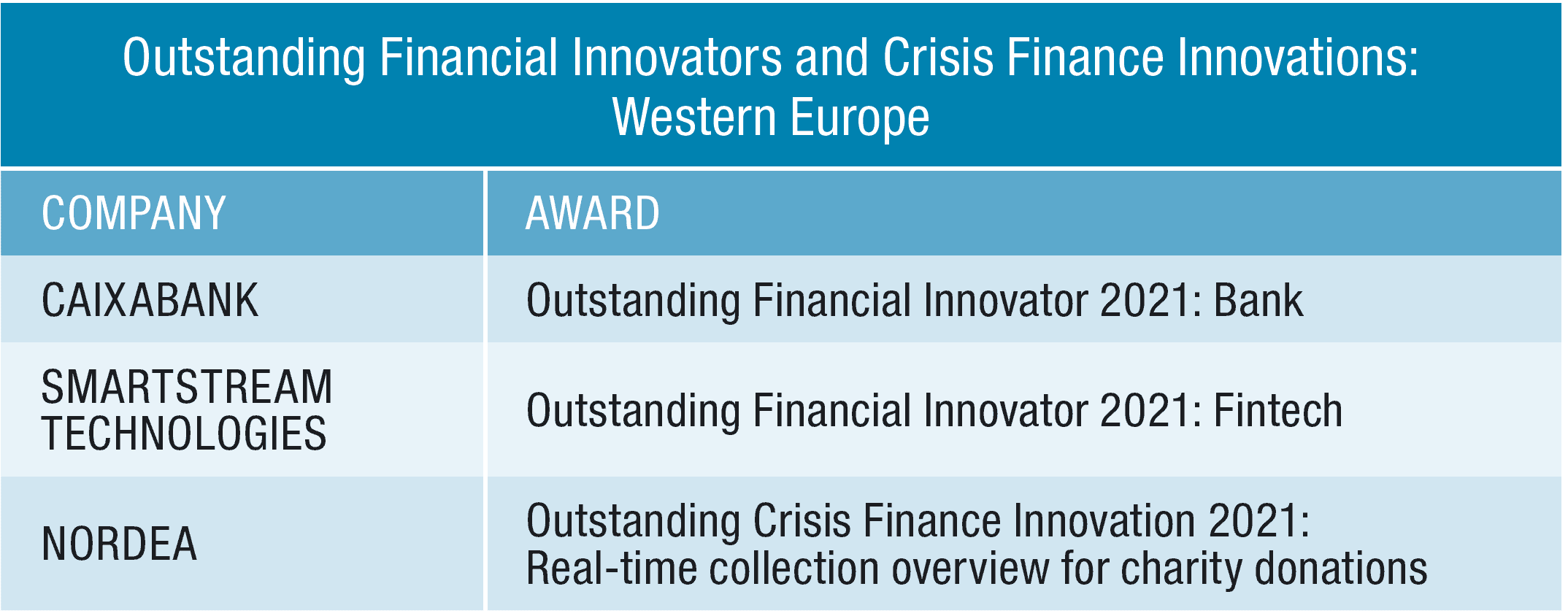Armed with new technologies, banks are finding new ways to keep customers happy and themselves profitable.

In Western Europe, banks are bridging the gap between corporate and consumer banking as everyone is getting used to new ways of working.
“At CaixaBank, we understand technological innovation is a fundamental element of the strategy to continuously improve our clients’ customer experiences,” says Jordi Nicolau, director of retail banking and customer experience at Western Europe’s Outstanding Financial Innovator. “For this reason, CaixaBank is exploring the use of biometrics, one of the fastest-evolving technologies, which is revolutionizing people’s interactions.”
In 2017, CaixaBank became the first bank in Spain to incorporate Face ID on the iPhone X, then a newcomer to the market. Recently, CaixaBank became the first financial institution to offer facial recognition instead of PIN codes to make ATM withdrawals. “It speeds up the customer identification process and facilitates withdrawals,” explains Nicolau. “The ATM validates up to 16,000 points of the user’s face image.”
Although business users make much more professional use of digital banking than retail users, Nicolau says business users, like retailer users, expect customized experiences adapted to their day-to-day lives. “The Spanish market also has a large presence of self-employed professionals who expect to be able to operate in their professional and personal World’s seamlessly,” he adds.
In any case, Nicolau says experiences for companies are much more complex than those for individuals, due to product specialization and the different types of profiles that interact within a company, such as financial, administrative, audit and others. To this end, CaixaBank also launched a new home banking service for companies in 2020, with a custom dashboard that offers a global view of the company and other features.
The Outstanding Financial Innovators award for fintechs went to SmartStream Technologies for the development of its Intraday Liquidity Stress Testing module, which reduces testing times for banks from weeks to minutes.
“Market, credit and operational risk have all increased markedly,” states Nadeem Shamim, head of cash and liquidity management at SmartStream. “For instance, banks have been encouraged to lend to companies; but the economic uncertainties facing those borrowers have been unprecedentedly raising credit risk, which directly impacts liquidity. Studies have shown considerable losses prior to the pandemic due to operational risks, which are only likely to have increased. The key challenge to actively manage intraday liquidity is getting up-to-date information in a timely manner.”
The automated platform monitors a bank’s liquidity in real time and manages daily processes while reducing the costs to a bank of meeting its monitoring and reporting obligations. It alerts users when the bank breaches a limit. It also reduces reliance on manual intervention, he adds.
Western Europe’s Outstanding Crisis Finance Innovation award goes to Nordea Bank for a real-time mobile payment platform its Open Banking team developed for the Swedish mobile payment system Swish. By providing the Swish mobile payment app and Nordea’s Instant Reporting application programming interface (API), Nordea was able to help Swedish charity Majblomman, known for its annual sale of paper-flower pins to fight tuberculosis, to create a fully digital user experience for the collectors. By having direct access to Swish via an Instant Reporting API, the charity can track the collections of each group of fundraisers, who have different QR codes that they can share on social media to encourage more donations.




